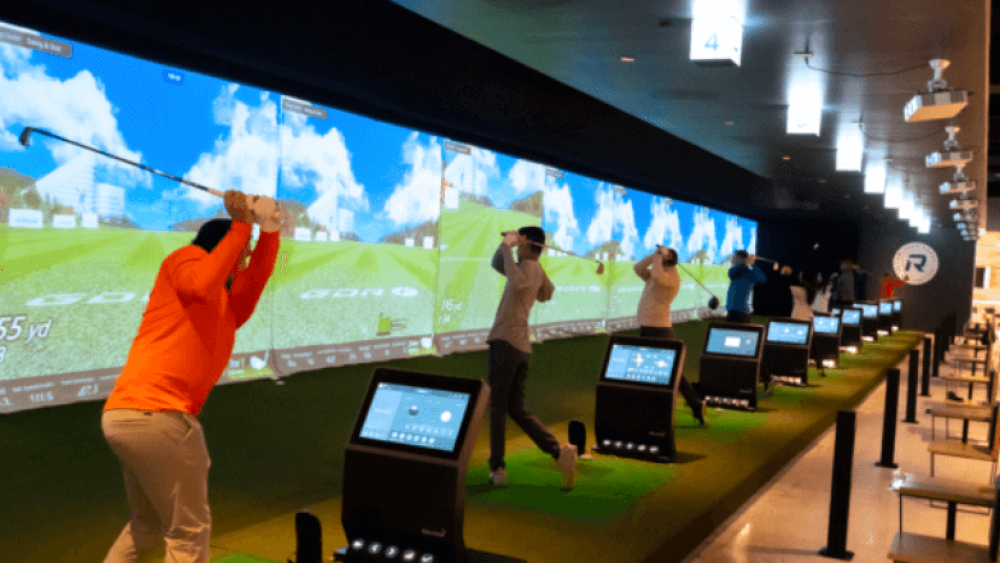Golf simulators aren’t just for entertainment and fun – they can also be powerful golf training aids for skills development and teaching, especially for golf academies, teaching studios and golf entertainment centers looking to offer golf classes and training.
Whether you’re a beginner, or the parent of a beginner, looking for ways to boost your game all year round or a golf business or trainer looking for new ways to teach your customers and students, there’s a simulator for you.
Benefits of Golf Simulators for Training and Teaching
For students, golf simulators can provide a convenient and cost-effective way to learn and improve your golf skills without traveling to a golf course or paying for green fees. For teachers, golf simulators can help you to expand your customer base, increase revenue and improve your teaching quality.
And that’s just the tip of the iceberg, with golf simulators being an invaluable investment for personal and commercial use. So what other benefits can you expect?
Year-Round Practice Opportunities
With golf simulators, you can practice your golf skills anytime and anywhere, regardless of the weather or daylight conditions, with ease.
You can also play on hundreds of world-famous courses without leaving your facility, meaning you can practice in immersive environments across various conditions to keep you on your toes.
Instant Feedback For Quick Results
Golf simulators provide instant feedback on your swing and ball flight, such as club speed, ball speed, launch angle, spin rate, carry distance, total distance and smash factor. You can also see your shot trajectory, landing spot and dispersion on a 3D simulation or a video replay.
This instant access to impactful data can give you real-time tips on how to adjust and pivot stance while teaching golf strategy to your student or customer. It’s equally powerful for beginners looking to make live adjustments to their form and swing.
More Enjoyable Game Improvement
If you want to learn and grow, but more importantly have fun doing it, you need a golf simulator.
Golf simulators help you improve your game by offering various game modes, challenges and drills. You can practice specific aspects of your game, such as driving, approach, short game or putting and even test your skills against other players or yourself in tournaments or competitions.
Boosted Student Engagement
Golf simulators make golf training and teaching more engaging and fun for your students, too!
You can create customized lessons and programs based on your student’s goals and abilities. You can also use interactive features like voice commentary, swing tips, games and music to enhance the learning experience. This will keep your students coming back for more.
How to Use Golf Simulators as Effective Golf Training Aids
Ready to take the next step? Golf training simulators are great for golf practice and training. But how do these simulators work and what goes into incorporating them into your next practice round? Follow our helpful outline below to get started.
Choose the Right Golf Simulator
Not all golf simulators are created equal. It’s imperative to choose a golf simulator that suits your space, budget and needs. You also need to consider the quality, accuracy and reliability of the simulator’s hardware and software. Some of the factors that you should look for when choosing a golf simulator are:
- Sensor technology: There are different types of sensor technologies used by golf simulators; you should choose a sensor technology that can capture your swing data accurately and consistently.
- Screen size and resolution: The screen is essential – it’s what creates the entire experience. Consider a large screen to give you a realistic and immersive experience. It would be best to choose a screen with a high resolution and brightness to ensure clear and vivid images.
- Variety and quality of the courses: The best golf simulators map real-life courses to create virtual golfing environments that are crisp, enticing and dream-fulfilling. It would help to choose a simulator that offers various courses from different locations, difficulty levels and styles, utilizing high-quality graphics and sounds to create a realistic and enjoyable atmosphere.
- Software features and functions: The software powers the simulator and provides feedback and analysis critical for growth and training. That’s why choosing a software with user-friendly interfaces and menus, easy-to-use settings and modes and comprehensive data and statistics is important.
Set up the Simulator Properly
You also need to set up the simulator properly according to the manufacturer’s instructions. This, of course, ensures you’re getting everything you can out of the golf practice simulator you choose for golf teaching and/or training.
What’s more is you need to ensure your simulator is calibrated correctly, the sensors are aligned properly, the screen is clear and bright, the sound is audible and the internet connection is stable.
Ensure your space is clear, accessible and prepped. Connect all wires to power sources, external devices and more. Set up your personal preferences and you’re ready to go. It might also be beneficial to work in a few practice swings to ensure everything is working properly and providing you with the best golfing experience possible.
Explore Simulator Settings & Features
In order to optimize your training and teaching outcomes, you need to explore what additional simulator features can be adjusted and switched to meet your needs.
You need to select the appropriate courses, settings and modes for your practice sessions or lessons. Adjust the difficulty level, weather conditions and tee boxes according to your skill level or preference.
This creates a truly custom experience that will help you reach your goals in your own time.
Some of the tips that you should follow when using the simulator features are:
Tip #1: Choose Courses That Match Your Goals
Choose golf courses that match your goals for improving your swing or game. For example, if you want to work on your accuracy, choose courses with narrow fairways, tight greens, or hazards. Choose classes with long holes, wide fairways, or elevation changes to work on your distance.
Tip #2: Choose Settings That Simulate Real Situations
You should choose settings that simulate real situations that you may encounter on a golf course. For example, if you want to practice playing in different weather conditions, choose settings that vary the wind speed, direction, or gusts. If you want to practice playing at different times of day, choose settings that change the sun position, angle, or brightness.
Tip #3: Choose Modes That Challenge Your Skills
You can decide on modes that challenge your skills and test your performance. For example, if you want to practice your swing mechanics, you should choose modes that provide swing analysis, feedback and tips. If you want to practice your game strategy, you should choose modes that provide course management, shot selection and scoring options.
Review Feedback Carefully
Feedback is essential, so pay attention.
You need to review the feedback carefully after each shot or session. Pay attention to the data points, visuals and statistics that are relevant to your swing or game improvement. Identify your strengths and weaknesses and work on them accordingly.
How to Review Your Golf Data the Right Way
There’s definitely an art to understanding and using golf simulator data in the right way.
Analyze the data points
You should analyze the data points that show the details of your swing or shot, such as club speed, ball speed, launch angle, spin rate, carry distance, total distance and more.
Observe the visuals
Observe the visuals that show your shot’s trajectory, shape and landing, such as ball flight, ball path, ball curve, ball bounce, ball roll and more. You should see how these visuals match or differ from your intended or expected outcome and what factors affect them.
Study the statistics
Numbers matter, so study the statistics available on the screen. These data points can outline averages, changes and trends when it comes to your performance, such as average values, standard deviations, dispersion patterns, consistency rates and accuracy rates.
You should see how these statistics reflect or influence your overall swing or game quality and what areas need improvement.
Track Progress Consistently
Track your progress consistently over time by keeping a record of your data and results regularly and compare them with your previous performances or benchmarks; make sure to set realistic goals and measure them periodically.
That’s where a golf simulator comes in.
Golf training programs that incorporate golf simulators provide a physical location where all past progress and performance can be monitored and referenced. You can see these results in real time, making taking accountability and responsibility for your progress easier.
This easy-to-access data can help you craft a proper golf swing training program or set of goals for a customer or student. For those using simulators as a makeshift golf teacher, these stats can work as easy-to-see reminders of milestones to continue working through.
Usher In a New Generation of Golfers With GOLFZON
GOLFZON knows golf. But we’re more than just a golf simulator brand. Our golf community welcomes everyone who shares a passion for the game. Whether you want to invest more time into your own game, in your own space and on your own time with a golf simulator, or you want to use the tools to train the next generation, GOLFZON knows how to help you achieve your goals.
Our GOLFZON TwoVision comes equipped with a variety of exciting features that can help you revolutionize your golf teaching experience. These features make a definitive difference:
- The dual-sensor system: The dual-sensor system consists of two high-speed, high-definition cameras that capture the ball flight and swing data at a whopping 400 frames per second. It also includes a built-in T4 sensor in the touchscreen kiosk that provides additional shot and club data on the driving range, along with a virtual caddie feature.
- The moving swing plate: The TwoVision simulator features a moving swing plate that can tilt and rotate according to the slope and lie of the simulated course. The moving swing plate allows the players to experience the true golf course contours and uneven lies that they may encounter on an actual course, helping them adjust their stance, posture, balance and weight transfer according to the terrain conditions, which can help them improve their shot quality and consistency.
- The swing analysis: The TwoVision simulator provides a comprehensive swing analysis that can measure and display various data points. The swing analysis can help the players identify and correct their swing faults, track their progress and customize their training programs. The swing analysis can also help the teachers monitor and evaluate their students’ performance, provide personalized feedback and guidance and design effective lesson plans.
GOLFZON golf simulators like TwoVision are great for teaching and training because they provide a convenient, cost-effective, fun and engaging way to learn and improve golf skills.
They can also provide a realistic and immersive way to experience golf in a virtual environment, allowing players to play on famous courses around the world, challenge themselves with different modes and levels of difficulty and socialize with other players online or offline.
From personal use to large-group teaching, GOLFZON has some of the best golf simulators for you to practice on, offering unlimited opportunities to grow, develop and perfect every aspect of your game.



